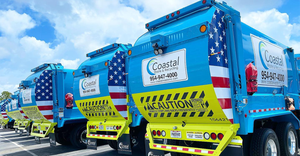Profiles in Garbage: Newspaper 1050
Newspapers are printed on newsprint, an uncoated groundwood paper made by mechanically grinding wood pulp without first removing lignin and other wood pulp components. This creates a different product than the chemical pulping process used to make office paper and other paper grades. Newspapers are the largest component by weight and volume of a curbside recycling program.
More than 56 million newspapers are sold every day by 1,489 daily newspapers in the United States, averaging 2.2 readers per copy. On Sunday, 897 American newspapers sell more than 60 million papers, averaging 2.3 readers per copy. In addition, 8,193 weekly newspapers sell more than 74 million copies a week.
Newspapers generated increased by 6.4 million tons since 1960, but its market share of solid waste decreased by 23 percent. Newspaper recycling increased by 5.5 million tons and the recycling rate doubled during this same period.
Newspaper Municipal Solid Waste (MSW) Facts Generated: * 13.5 million tons, or 6.2% of MSW by weight.*
* 11 million tons of this are newspaper.*
* 2.5 million tons are advertising inserts printed on newsprint.*
* 99.9 pounds per person per year.*
* 118 news pages per pound (1995).
Recycled: * 7.4 million tons for a 55% recycling rate.*
* Industry data shows 8.8 million tons recovered in 1998 for a 69% recycling rate.
Recycled Content: * 28% of the fiber in American newspapers comes from used newspapers.
* 27 states have voluntary or mandatory requirements that newspapers sold in those states contain prescribed amounts of recycled fiber.
Composted: * Highly compostable with only traces of ink in the compost.
Incinerated or Landfilled: * 6.1 million tons or 3.9% of discarded MSW by weight.*
* 7,500 Btus per pound vs. 4,500 to 5,000 Btus for a pound of garbage.
Landfill Volume: * 15.3 million cubic yards or 3.6% of landfilled MSW by volume.*
Density: * 12-inch stack weighs 35 pounds.
* Loose, unbaled newspapers weigh 360 to 500 pounds per cubic yard.
* Baled newspapers weigh 720 to 1,000 pounds per cubic yard.
* Landfilled newspapers weigh 800 pounds per cubic yard.
Source Reduction: Newspaper standard basis weight from 32 pounds per 3,000 square feet in 1974 to 30 pounds per 3,000 square feet in 1995.* The average number of news pages per pound increased from 93 in 1985 to 118 in 1995.*
Other reduction techniques include reducing the circulation area by printing fewer copies; printing fewer overissue copies and using a smaller web printing press size to produce a smaller paper.
Newspaper Markets: Old newspapers' largest market is the recycled newsprint industry, which recovers clean pulp by deinking old newspapers. Thirty out of 35 North American newsprint mills produce significant recycled content.
Exporting old newspapers to papermills in Canada and other companies is the next largest market, followed by recycled paper board mills, which produce boxboard packaging used for cereals, shoes and other products.
Other markets include cellulose insulation and animal bedding.
End-Market Specifications: Newspapers collected at the curbside meet the Institute for Scrap Recycling Industry's Paperstock Grade 6 (news) requirements of no more than 1% prohibitive materials and 5% outthrows.
Contamination during collection is a major problem. Newspapers should not be mixed with food, broken glass or other paper grades.
Processors buy loose newspapers, pull out contaminants, bale the newspapers and sell them to an end-market. Newsprint mills buy Grade 8 (special news deink quality), which allows no prohibitive materials and no more than 0.25% total outthrows. Many newsprint mills reject newspaper published with flexographic inks because it's difficult to remove from paper fibers.
Newspaper Cost and Value: * Collection costs range from $60 to $90 per ton.
* Processing costs range from $20 to $55 per ton.
American Forest and Paper Association, Washington, D.C. Website: www.afandpa.org
"Characterization of Municipal Solid Waste in the United States: 1998 Update," U.S. Environmental Protection Agency (EPA), Office of Solid Waste, 1999, Washington, D.C. Website: www.epa.gov/osw
"Measurement Standards and Reporting Guidelines," National Recycling Coalition, Alexandria, Va., 1990. Website: www.nrc-recycle.org
National Solid Wastes Management Association's Waste Recyclers Council: Processing and Collection Cost Studies, Washington, D.C. Website: www.envasns.org
Newspaper Association of America, Falls Church, Va. Website: www.naa. org
Rhode Island Department of Environmental Management, 1990, Providence, R.I.
"Scrap Specifications Circular 1999: Guidelines for Paper Stock," Institute of Scrap Recycling Industries, Washington, D.C. Website: www.isri.org
*1999 U.S. EPA estimates.
About the Author
You May Also Like




